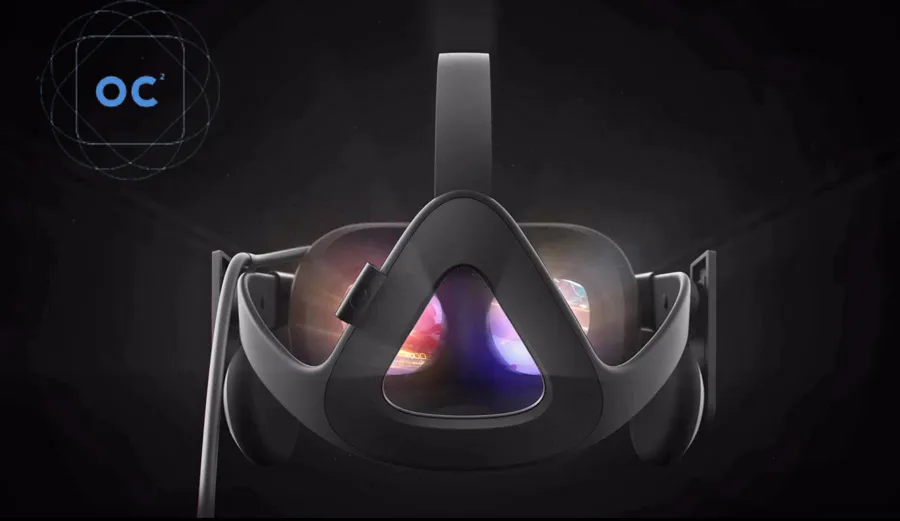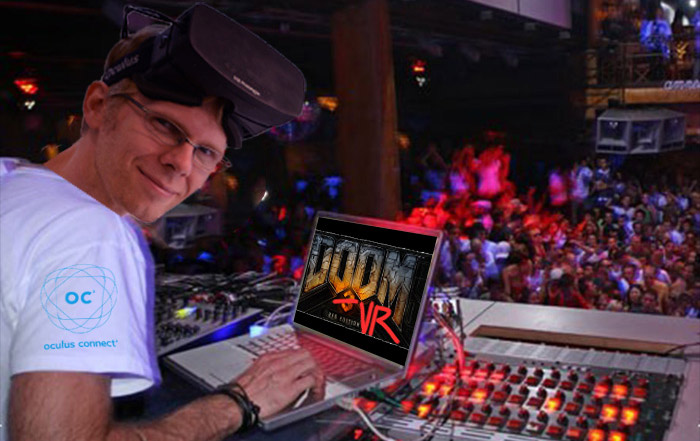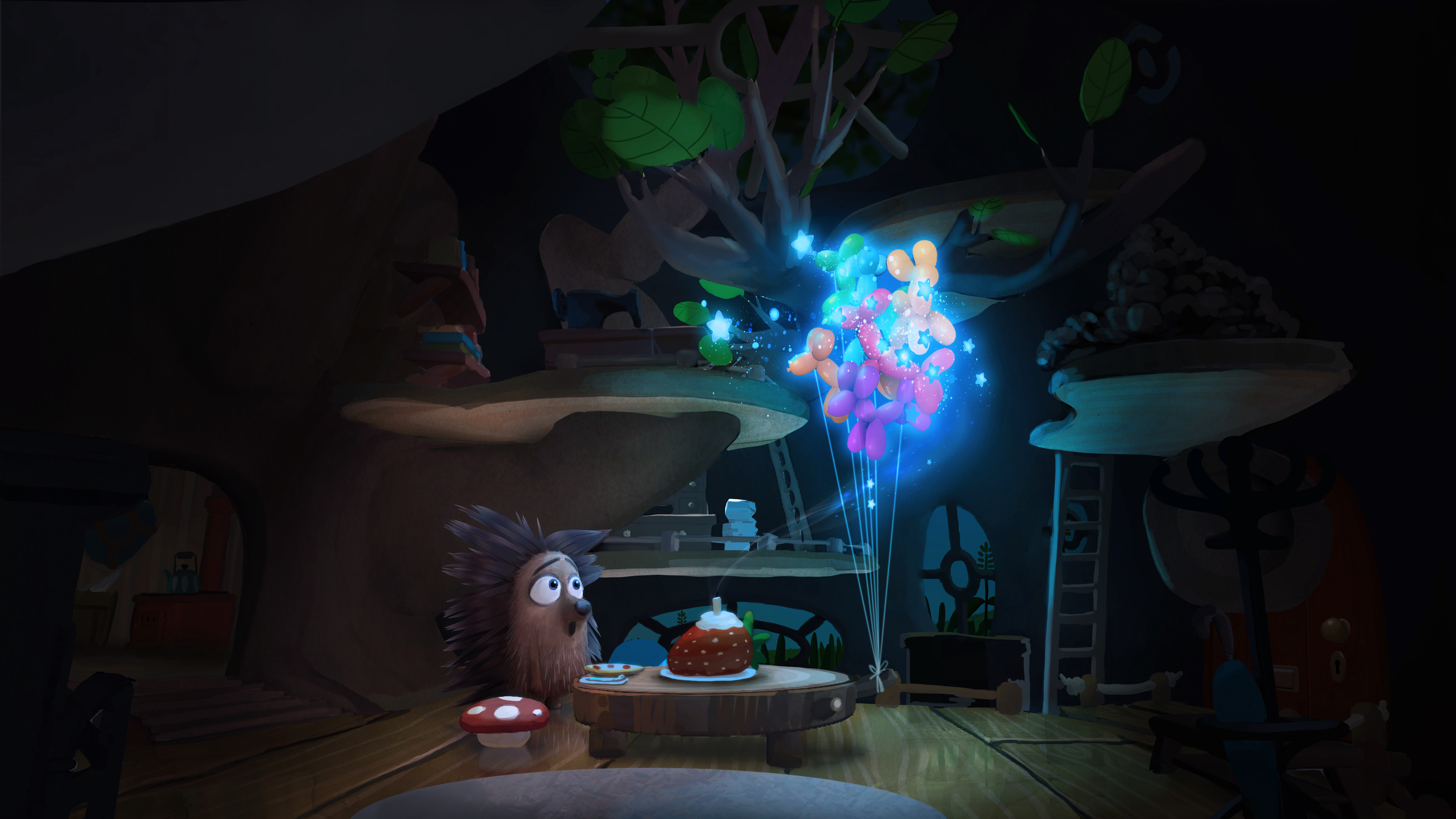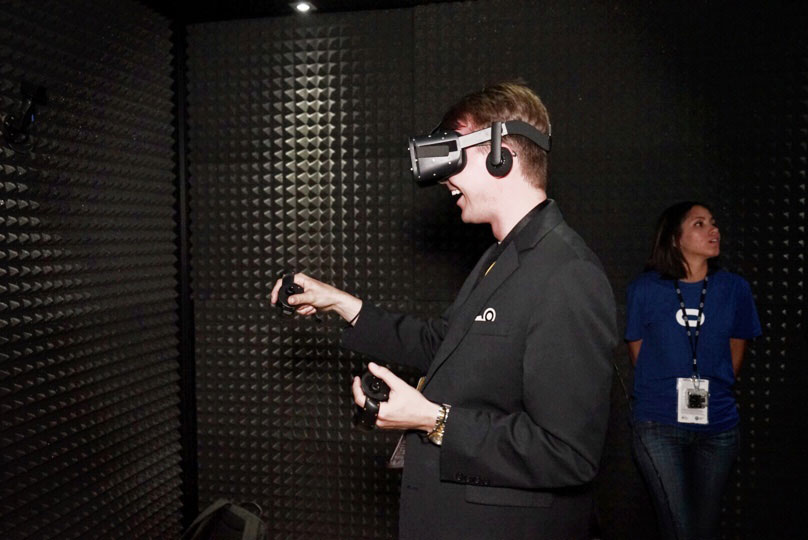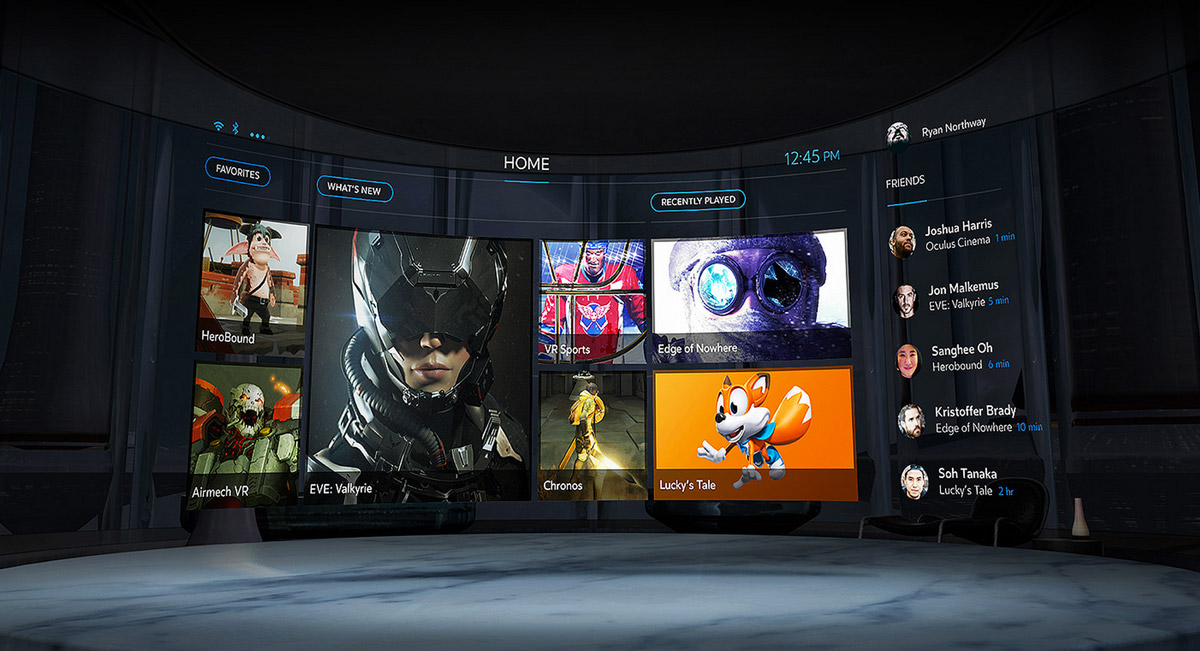Virtual reality is about to hit the mainstream. With the release of consumer headsets coming early next year, the Oculus Rift will be available to millions of consumers. No more dev kits. No more waiting. It’s finally here.
This is an exciting moment for the VR community as our dreams start to become, well, reality . It’s also terrifying, as it’s time to finally execute on all of the plans we’ve been forming over the past few years.
Next week thousands of virtual reality developers will descend on Loews Hotel in Hollywood, California for Oculus Connect, the equivalent of Apple’s famed WWDC (Worldwide Developer Conference) for the current VR ecosystem. It might not have the same panache as the exclusive Apple event quite yet, but it’s the closest thing VR has to a global meeting of the top minds in the industry. It’s a chance for the leading VR company to connect with developers, share ideas about the future of the medium, and show off their latest technology.
No one outside of the company knows for sure what we’re going to see, but careful parsing of comments from Oculus over the past few months should give us some indication. Without further ado, here are seven six things we should watch for at Oculus Connect 2.
1. Positional tracking for GearVR

Probability:
[Editor’s UPDATE 9/22/15: Not Happening] Palmer Luckey took to reddit today to begin setting expectations for Oculus Connect and some of the news he brought wasn’t good for those of us who were hoping for positional tracking for the mobile device (like ourselves).
“In the spirit of killing overhype: Not going to happen. Our computer vision teams are doing some amazing work, but VR-grade inside-out tracking is not currently workable on mobile devices.”
Drats. Though enthusiasts shouldn’t be deterred, Luckey promised many exciting announcements for this week.
Impact: Would have been Massive
It’s no secret that Oculus and John Carmack are huge fans of mobile VR. And if your goal is to bring VR to as many people as possible over the next few years this makes total sense — there are three or four orders of magnitude more VR capable cell phones than there are gaming PCs in the world.
The Gear VR Innovator Edition is already a great piece of hardware that provides a shockingly good VR experience. We bring the Gear to just about every networking event we go to and it almost never fails to elicit positive reactions.
But there’s a critical feature that the Gear VR is missing — positional tracking. Positional tracking in VR is when the virtual world reacts not just to the rotation of your head, but its position as well. Positional tracking allows you to lean in close to examine a VR object lying on a table or peek your head around a corner in a FPS game.
Positional tracking is massively important in VR for two reasons. First off, it is a serious force multiplier for immersion. There’s nothing quite like being able to move around fluidly in VR and positional tracking is crucial for achieving that all important sense of presence.
Positional tracking significantly reduces motion sickness. It’s no secret that motion sickness could be the Achilles Heel of VR. VR sickness is caused, in short, when your brain’s expectation of reality isn’t matched up with what it sees. We can tell you from experience that standing up while wearing a VR headset and not seeing the world shift at all is not a fun experience.
Getting positional tracking onto Gear VR would be huge and solidify its place in the pantheon of serious VR. But most of us in the VR community had assumed it wasn’t going to happen for a while, since positional tracking is a far more difficult problem on a mobile headset than desktop headsets.
The excitement has been generated by a handful of cryptic comments from Oculus CTO John Carmack, combined with recent rumblings from Samsung. In August 2015, Carmack told VR fans on Twitter not to buy a new phone for VR until Oculus Connect. So we know something is happening. He followed this up saying “we’re going to accomplish a whole heck of a lot this year, and others will say there is no way we can. Well, maybe. But we know we’re going to get more done than people think is possible.”
There are a couple signs indicating that this “impossible feat” is positional tracking on the Gear VR. First is the fact that the Galaxy S7 might have a depth sensing camera. Such a camera would be massively useful in attempts to bring positional tracking to the Gear VR. Combine this with the fact that two recent Oculus acquisitions (13th Lab and Surreal Vision) have the exact type of computer vision experience that you would need to get something like this off the ground and things start to get very interesting.
Watch out for this one folks.
2. VrScript shows a new way to program for VR
Probability: Certain
Impact: Low to gamechanging
At Connect, John Carmack is going to publicly demonstrate his new platform for developing virtual reality experiences — VrScript. VrScript could solve one major problem with VR.
Right now, using VR is an incredible, awe inspiring experience. But developing for VR, is reminiscent of bashing your face against a wall repeatedly.
Ok well maybe it’s not that bad — but there’s one area which is a huge hassle. Going from development to testing and back to development again. Having a tight feedback loop is critical to being able to rapidly iterate on the program you are working on. This is one of the reasons why compiled programming languages like C++ have given way to modern integrated languages like Javascript or Python. This shift is one of the many reasons that programming has become far more agile over recent years, creating in days what before would have taken weeks or months.
Right now developing for mobile VR is like programming in a compiled language. You have to create the build on your computer, package it up and then try it out on a VR headset. It’s a long process that can take you out of the feedback loop that’s so critical to great development.
Which is why it was so exciting when John Carmack announced that he was working on a VR scripting language, creatively titled VrScript to solve these problems. And in typical Carmack fashion, he threw a ton of the technical details out there for anyone who could parse it.
VrScript will allow you to make changes to your code on your computer and then see “subsecond” updates to your product. Changes that before could have taken many minutes or hours to see are now nearly instant.
When John Carmack takes the stage later this week, we’re going to see the first glimpse of the potential future of VR development. Of course, it’s only the future the VR community get behind it. Personally, we can’t wait to try it out.
3. Oculus Story Studio shows us the future of storytelling
Probability: Certain
Impact: Pixar … who?
Oculus Story Studio had their big debut at Sundance this year with the release of “Lost”, the first animated short film for virtual reality. The mission of the in-house studio is to develop the first generation of VR filmmaking techniques and disseminate them to the VR ecosystem as a whole. This is because making movies for virtual reality is entirely different than traditional filmmaking — there’s no frame, the audience doesn’t know where to look, and moving the camera can be jarring for viewers.
In order to solve these problems, Oculus brought together a dream team of former Pixar executives and Lucasfilm veterans. According to Edward Saatchi, the producer for Story Studio, “Story Studio is designed to inspire and educate — inspire by making awesome movies and educate by sharing our information with the community.”
And share they did. In July, they released a blog post detailing the lessons they learned from making Lost including everything from how to set the scene to the best way to direct a user’s attention. Only a month later they’re released detailed information on the tools they use to make animated VR films.
Story Studio hasn’t been developing these techniques as an academic exercise. As Saschka Unseld, the creative director for Story Studio, makes it very clear, “You learn by doing.” So for the past year they have been working on their second film Henry about a hedgehog that needs a hug (with a voiceover by Elijah Wood!).
Attendees of Oculus Connect will reportedly get the chance to watch Henry, which premiered in Los Angeles at the end of July. But more important than that, they will hear from the Saschka and the rest of the Story Studio team about all of the innovative VR filmmaking techniques they learned while making it. The hope is that by spreading these techniques, other VR filmmakers will be able to create compelling and interesting content for the Rift before it comes out.
While a talk about VR filmmaking techniques is absolutely certain as indicated by the event schedule, it’s also possible that they will release more information about their next two VR films. Story Studio is reportedly going to release four films with the Rift, so it would be fascinating to see a sneak peek of what’s coming next. Every story provides different technical challenges so their choice of project could indicate the type of tools and techniques they are experimenting with.
Even more interesting would be if they announced partnerships with other film studios. When Oculus announced Story Studio, Brendan Iribe explained that they created the studio after filmmakers became excited about making VR films with Oculus, but they “didn’t have answer for them.” Now, after nearly a year of experimentation, maybe they’re ready to bring some of those Hollywood studios on board.
Toy Story, Finding Nemo, The Incredibles. These films have touched our hearts and become cultural icons. Next week, we’ll find out if Henry might be next.
4. Development Kits for Oculus Touch
Probability: “We have nothing to disclose at this time”
Impact: High
Head Mounted Displays like the Oculus Rift are really only half of a compelling virtual reality experience. Because you don’t just want to see the world. You want to interact with it. And that’s where VR input comes in.
At the “Step Into the Rift” event last June, Oculus finally showed off the consumer version of the Rift before taking a leaf out of Apple’s book to finish with the biggest news of all — a VR input device native to the rift called Oculus Touch.
Oculus Touch is a pair of tracked controllers that allow users to interact naturally with a virtual environment. In addition to tracking the controllers in 3D space, the controllers also have a variety of buttons, thumbsticks, and triggers. Even more interesting is the basic finger gesture recognition that will allow us to point, wave, and give a thumbs up in virtual reality. So far all of the reviews of Oculus Touch have been absolutely amazing. It seems like one of the best ways to interact with virtual reality that is currently available.
This was incredibly exciting news from Oculus after months of hopes and speculation about their fabled input method. The only issue is that since the event very few people have had the chance to try it and even fewer have had the chance to develop with them. At the event they committed to releasing Touch at the same time as CV1 (but not together). That leaves six months for developers to create experiences for it and so far Oculus has only released a very limited number of dev kits.
Although Oculus made it clear during the announcement that they were focusing on the gamepad controller for early Rift games, it seems unlikely that they can wait much longer before getting Touch dev kits in the hands of developers. If they want there to be at least some reason to buy Oculus Touch upon its release, they’re going to need to have content.
Our bet is that they announce pre-orders for an Oculus Touch dev kit at Connect. They should be ramping up production of CV1 right now so they should have the capability and scale to produce at least a few thousand Touch dev kits before launch. The Touch prototypes they showed at the CV1 event seemed almost complete and if they have already been releasing dev kits to some developers they must be relatively solid and functional. This seems like the perfect moment to get developers excited about using Oculus Touch before giving it to them for experimentation and development.
5. Oculus Home Shows Us the Future of Content Distribution
Probability: High
Impact: High
How are we going to get new VR games and experiences? We know we won’t be walking to the store to pick up a physical copy – Oculus has stated they are sticking to digital distribution of their content. They’ve already given us a taste of what this will look like with Oculus Home, their content platform for the Gear. At Connect, we’re going to be getting more info about the form of Oculus Home.
Will it be a Steam knockoff? Will there be an actual VR retail experience? It’s going to be very interesting to watch the development of their store.
Video game sales are big business. Video game sales topped $86 billion in 2014 and every indicator shows that they’re only going up from there. And it’s not physical sales of games that are driving this upswing – it’s digital distribution. Right now, Valve is the clear leader in this market, capturing a significant portion of all PC game sales.
If Oculus wants to thrive in the long term, they need to be more than just a hardware producer. They need to become a platform. In order to do this, they’re going to have to make sure that they control the central content distribution platform in VR.
Another things to watch for here is openness. Oculus has said the Rift will be an open platform. We’ll have to watch and see if their actions match the promises. Personally, we’re optimistic about this, but we’ll know much more later this week.
6. Micro-Virtual Transactions and Social VR

Probability: Medium
Impact: FarmVRVille?
Ever since the Facebook acquisition, the VR community has been wondering when we would start to see some Facebook influence on Oculus. It looks like we’ll get a hint at a panel on Thursday called “Oculus Platform: Building Social, Game Services and Commerce into VR Apps”.
The aim of this session will be to “introduce the new Oculus Platform – a set of services to help developers easily build social, identity, commerce and more into their Rift and Gear VR apps”. This description brings to mind some very interesting potential scenarios.
The first and most likely is microtransactions within Oculus games and experiences. Anyone that has ever played Candy Crush knows the potential power of microtransactions. And that power is going to increase exponentially in virtual reality.
Even more significant is the “identity” aspect. Having a shared identity across separate VR games and applications is crucial to building the foundations of the metaverse. If Oculus is building the standards around this, that means that they’re starting to look ahead to the social VR platform of the future where we can seamlessly morph between different worlds.
The Metaverse is coming. We know Oculus wants to be the ones to power it. We’re looking forward to hearing the first specifics of their vision.
7. Michael Abrash blows our collective mind with the future of VR

Probability: Certain
Impact: “This is your last chance. After this, there is no turning back. You take the blue pill — the story ends, you wake up in your bed and believe whatever you want to believe. You take the red pill — you stay in Wonderland and I show you how deep the rabbit-hole goes.”
There are a lot of legends at Oculus. Carmack has singlehandedly revolutionized the tech world several times. Palmer Luckey brought VR back from the grave to become a multibillion dollar industry. But for sheer, long-term vision about the future and power of VR, there’s no one out there that beats Michael Abrash, Chief Scientist at Oculus.
Abrash has a keen eye for the future. At his Oculus research lab in Seattle, he is working away with some of the brightest people in the world to create the next generation of VR tech. Think next gen input, locomotion and even augmented reality systems.
Abrash’s talks always leave you feeling awed at the sheer scope and power of virtual reality. In fact, it was a talk by Michael Abrash that convinced us to start a virtual reality company almost two years ago. The title of that talk “What Virtual Reality Can Should and Probably Will Be Within Two Years”. Seriously — you should check it out. Abrash outlined a stunningly convincing scenario about the ways VR was going to start to change the world over the next two years. Looking back, it is almost eerie how spot on his predictions were.
As we head into a new era of VR, I can’t wait to see what Abrash has in store for us next. The only thing I’m sure about is that this talk will be inspiring enough to make someone else dive into VR. Maybe it’ll be you?


Matthias McCoy-Thompson and Jason Ganz are the founders of AgoraVR. We create tools for companies, organizations, and individuals to present and share their ideas in virtual reality.
A version of this article was first published on Medium on September 18th, 2015. Follow The Metaverse Muse for more great VR news and analysis. If you’re attending Connect and want to chat about anything — VR or otherwise — shoot us a message on Twitter!

